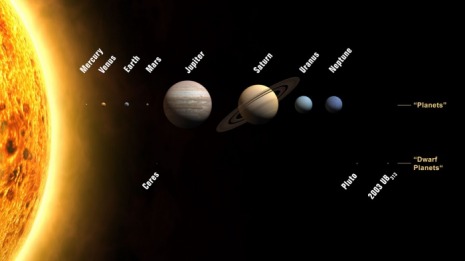The Planets in our Solar System
In the Solar System

the planets, and some dwarf planets
In the Solar System there is the Sun, eight planets and the moons, and billions of celestial objects. The celestial objects all orbit the Sun.
There are planets that are close to the Sun, and planets that are further away.
For example: - Mercury is 58 million km away from the Sun
- Neptune is 4 billion km away from the Sun
If someone was traveling across the Solar System, traveling at 28 000 km/h, it would take them 50 years!
The distances in the Solar System are so large, that astronomers need to use a measurement that is more convenient than the kilometer. This measurement is called the astronomical unit. It is approximately 15 million kilometers. Astronomical units give the astronomers a more practical measurement.
For example: Jupiter is 780 million kilometers away from the Sun, which is equal to 5.2 AU (astronomical units)
The largest object in the Solar System is the Sun. Because it is so big, and close to the Earth you can see it all day. But sometimes at night, you can see some of the planets, such as; Jupiter, Mars, or Venus. There are eight planets in the Solar System. Mercury, Mars, Venus, and Earth are small, rocky planets & are the closest to the Sun. The outer planets; Jupiter, Saturn, Uranus, and Neptune are farther from the Sun & known as the gas giant planets.
Each of the planets are all unique and different from each other in many ways.
http://www.iau.org/public_press/themes/measuring/
this website is to help you understand the Astronomical Unit
